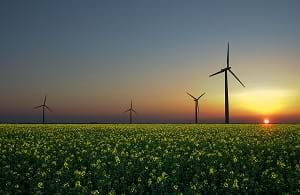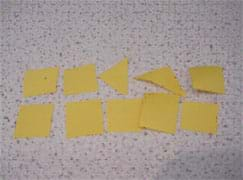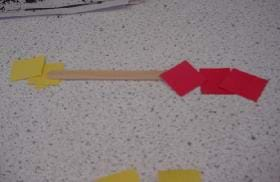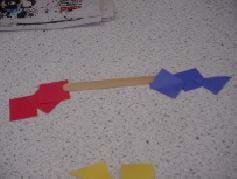Quick Look
Grade Level: 4 (3-5)
Time Required: 30 minutes
Expendable Cost/Group: US $5.00
Group Size: 15
Activity Dependency: None
NGSS Performance Expectations:

| 4-ESS3-1 |
Summary
In this activity, students simulate the equal and unequal distribution of our renewable resources. Also, they consider the impact of our increasing population upon these resources and how engineers develop technologies to create resources.
Engineering Connection
Bioengineers work with scientists in genetic engineering to modify or manipulate living organisms. By changing the genetics of foods and animals, they hope to provide more resources and develop food that can be grown in unfavorable soil conditions. Other engineers are creating methods that change the genetic make-up of crops to require fewer pesticides.
Learning Objectives
After this activity, student should be able to:
- Develop an understanding for the distribution of renewable and non-renewable resources.
- Understand the impact that the world's population growth has on our renewable resources.
- Understand how engineers work to develop larger amounts of resources for us to use.
Educational Standards
Each TeachEngineering lesson or activity is correlated to one or more K-12 science,
technology, engineering or math (STEM) educational standards.
All 100,000+ K-12 STEM standards covered in TeachEngineering are collected, maintained and packaged by the Achievement Standards Network (ASN),
a project of D2L (www.achievementstandards.org).
In the ASN, standards are hierarchically structured: first by source; e.g., by state; within source by type; e.g., science or mathematics;
within type by subtype, then by grade, etc.
Each TeachEngineering lesson or activity is correlated to one or more K-12 science, technology, engineering or math (STEM) educational standards.
All 100,000+ K-12 STEM standards covered in TeachEngineering are collected, maintained and packaged by the Achievement Standards Network (ASN), a project of D2L (www.achievementstandards.org).
In the ASN, standards are hierarchically structured: first by source; e.g., by state; within source by type; e.g., science or mathematics; within type by subtype, then by grade, etc.
NGSS: Next Generation Science Standards - Science
| NGSS Performance Expectation | ||
|---|---|---|
|
4-ESS3-1. Obtain and combine information to describe that energy and fuels are derived from natural resources and their uses affect the environment. (Grade 4) Do you agree with this alignment? |
||
| Click to view other curriculum aligned to this Performance Expectation | ||
| This activity focuses on the following Three Dimensional Learning aspects of NGSS: | ||
| Science & Engineering Practices | Disciplinary Core Ideas | Crosscutting Concepts |
| Obtain and combine information from books and other reliable media to explain phenomena. Alignment agreement: | Energy and fuels that humans use are derived from natural sources, and their use affects the environment in multiple ways. Some resources are renewable over time, and others are not. Alignment agreement: | Cause and effect relationships are routinely identified and used to explain change. Alignment agreement: Knowledge of relevant scientific concepts and research findings is important in engineering.Alignment agreement: Over time, people's needs and wants change, as do their demands for new and improved technologies.Alignment agreement: |
Common Core State Standards - Math
-
Represent and interpret data.
(Grade
3)
More Details
Do you agree with this alignment?
-
Fluently add and subtract multi-digit whole numbers using the standard algorithm.
(Grade
4)
More Details
Do you agree with this alignment?
International Technology and Engineering Educators Association - Technology
-
The use of technology affects the environment in good and bad ways.
(Grades
3 -
5)
More Details
Do you agree with this alignment?
State Standards
Colorado - Math
-
Represent and interpret data.
(Grade
3)
More Details
Do you agree with this alignment?
-
Fluently add and subtract multi-digit whole numbers using standard algorithms.
(Grade
4)
More Details
Do you agree with this alignment?
Colorado - Science
-
Earth and Sun provide a diversity of renewable and nonrenewable resources
(Grade
5)
More Details
Do you agree with this alignment?
Materials List
Each group should have:
- plastic chips or pieces of construction paper (10 per student)
- small container (to hold plastic chips/paper)
- small candies or other edible treats (enough for about 5 per student)
- 1 whistle or bell
- stopwatch (or clock/watch with a second hand)
- For alternate method:
- 10 plastic chips of pieces of construction paper in each color: yellow, red, blue
- 20 index cards or larger pieces of paper
Introduction/Motivation
It is estimated that 25,000 people die of hunger each day. Yet, 15% of the world's population consumes 70% of the world's grain supply (either directly or indirectly, by feeding livestock for later supplies of meat). Does that make sense? That means that a very small part of the world's population has access to a very large portion of a major world food group. Is food a renewable resource? No, it is a non-renewable resource. Once you eat something, it is used up and cannot be eaten again.
Agricultural engineers design food and farming technologies and equipment. They are concerned with human health and the increasing need for food. They work to develop ways to increase the number of animals and crops for the production of food, to protect these animals and crops, and to keep harmful germs from getting into our food. These engineers are helping both the farmers who grow livestock and crops and the consumers who buy the food.
To that end, specific engineers are researching and further developing food and animal genetics to create a greater resource for consumers. This means that they are modifying how these resources are actually developed. They are working towards creating foods that can last longer on grocery store shelves (so they can be shipped to countries that have less of that food) and creating foods that will grow in adverse conditions (so that countries with poor land resources can grow more of their own food). Some engineers are also trying to develop equipment and improve farming methods to ensure that these resources are more effectively used. Other engineers are developing technologies so farmers do not have to use harmful chemicals on the plants they grow to keep insects from eating crops before they can be harvested. These chemicals are called pesticides. Other engineers are producing robots, drones, and sensors to aud farmers so that they can more easily plant and monitor crops.
How do you think you would feel if there were not enough food resources for your family to eat? Do you think it is fair that wealthy countries get more of the resources? If we were able to save some resources in order to produce more in the future, how would that make you feel? During our activity today, we are going to look at how our food resources can increase and decrease.
Procedure
Before the Activity
- Buy enough candy or other edible treat so that each student has 5 pieces.
- Ensure that you have a large enough space for the groups to sit in circles.
With the Students
- Ask the class to brainstorm types of renewable resources. You may have to start them off. Suggest wind, water, solar, etc.
- Divide the class into two groups (10-15 students per group).
- Ask each group to sit in a circle (one circle per group) on the floor, facing each other.
- Tell the students that there will be no talking during the activity and that there will be several 15-second "rounds." A bell (or whistle) will sound at the end of each round.
- Count out 10 chips (or small pieces of paper) of any color for each student (per group) and put them in a container.
- Take ¼ of the chips from the container and put them in the middle of the circle (e.g., for 10 students, you will have 100 chips, and 25 of them will go in the middle of the circle). Do this in all circles if you have more than one.
- Tell students that each chip represents a renewable resource (such as wheat for food). Tell them that all of the chips belong to all of the students.
- Without talking, students must independently decide whether or not to take a chip (or chips) from the center of their circle. If they decide to take chips, they may trade in 10 chips for a piece of candy at the end of each round. But, there is a catch: when the bell/whistle sounds, the number of chips in the center of their circle will double. There will never be more chips than the original starting amount — a limit representative of the production capacity of these resources.
- Begin the first round with the groups. Be sure to enforce the "no talking" rule. At the end of the round, distribute any candy in exchange for 10 chips and double the remaining chips. (Place the chips you received in exchange for candy back in the container.)
- Continue to three rounds. Eventually, some students will begin to realize that the chips will double quickly if they do not remove all of them at once, and they will all have a chance at getting candy.
- If there are no chips to double, discuss the consequences. How does it feel not to get any chips? How does it feel to have some chips, but not enough for a candy? How does it feel to have enough chips to exchange it for a candy? Discuss ways to overcome the "shortage" problem.
- Play until everyone has received a piece of candy.
- Do the Post-Activity Assessment, as described in the Assessment section.
Alternate Method

- Divide the students into pairs. Each pair will represent a farm.
- Give each farm 10 yellow chips (see Figure 1).
- Explain the rules to the students:
- Each chip represents one crop, and each farm can grow a maximum of 30 crops at one time.
- Every season, the amount of chips (pretend seeds) that you plant will double. For example, if you plant 10 chips, the administrator needs to match the seeds with 10 more, for a total of 20.
- However, there is a problem. Farmers have to deal with floods, plagues, insects, overproduction, and soil depletion. To address this, have available 20 (enough for one per season for 5 years) index cards or larger slips of paper. Leave some cards/paper blank (representing a normal year, which means it is okay to double the seeds). On the remaining cards/paper write down a natural disaster (the students have a one in X chance — depending on how many you left blank and how many have a natural disaster written on them — of picking a natural disaster that will wipe out their crops for the season or year). Put all the cards/slips of paper into a box or hat and have a student pull one out for each season.
- Genetic engineers have a solution though. If a yellow tile is left alone for six seasons, genetic engineers can transform it into a plague-resistant plant (represented by red tiles, see Figure 2), meaning that only half of your crops will get wiped out.

- Even better, if your plague-resistant crops get left alone for another 4 seasons (for 10 total), they become immune to plague, and suffer no damage. Red tiles represent plague resistant crops, and blue tiles represent plague-immune crops. See Figure 3.
- Give the students a container that they can use to "store" their seeds for genetic modification. The seeds must stay in there for six seasons to turn red, and an additional four seasons to turn blue.
- Ten crops can be traded for one piece of candy. Although the students cannot eat the crops, they can eat the candy. Comparatively, farmers do have to eat. Therefore, your students have to consume one piece of candy per farm every two years, or they will starve (that means they must plan enough crops to be traded for candy to survive).
- Have the students place the chips on their farm (desk, floor, or other flat surface). Have one student reach into the hat and withdraw one piece of paper. If it is a plague, confiscate all the yellow tiles, ½ the red, and 0 of the blue tiles.
- Otherwise, double all the chips. Go through 5 years (i.e., 20 seasons) worth of game playing.

- After 4 seasons, have the students discuss their results. How many yellow crops will be left at the end? How many reds? How many blues? (Answer: There should probably be mostly blue tiles left.)
- Ask students if they think farming is easy. (Answer: No. There are a lot of risks, and farmers have to be very concerned about water, insects, fungus, birds, heat, cold, money, gas prices, overproduction, etc.)
- If time allows, explain the concept of a subsidy (i.e., the government pays the farmers not to plant crops to keep the price up for other farmers and to save the soil).
- At the end, have students trade in all the chips that they still have for candy. Remember- 9 chips are not enough to trade in for candy!
- Do the Post-Activity Assessment described in the Assessment section.
Assessment
Pre-Activity Assessment
Brainstorming: As a class, have the students engage in open discussion. Remind students that in brainstorming, no idea or suggestion is "silly." All ideas should be respectfully heard. Take an uncritical position, encourage wild ideas and discourage criticism of ideas. Have them raise their hands to respond. Write their ideas on the board. Ask the students:
- What are types of renewable resources?
- Discuss the effects the world's population growth has on our natural resources. Make sure students understand the cause and effect relationship.
Activity Embedded Assessment
Discussion Questions: After playing a few rounds of the activity game, discuss the following questions with students. Solicit, integrate and summarize student responses.
- How does it feel not to get any chips?
- How does it feel to have some chips, but not enough for a candy?
- How does it feel to have enough chips to exchange it for a candy?
- Discuss ways to overcome a "shortage" problem.
Discussion Questions (for Alternate Method): After 4 seasons, have the students discuss their results. Solicit, integrate and summarize student responses.
- How many yellow crops will be left at the end? How many reds? How many blues? (Answer: There should probably be mostly blue tiles left.)
- Is farming easy? (Answer: No. There are lots of risks, and farmers have to be very concerned about water, insects, fungus, birds, heat, cold, money, gas prices, overproduction, etc.)
Post-Activity Assessment
Toss-a-Question: Give the students a list of the questions below without answers. Have students continue sitting in a circle in their teams and toss a ball or wad of paper back and forth. The student with the ball asks a question and then tosses the ball to someone to answer. If a student does know the answer, he or she tosses the ball onward until someone gets it. Discuss answers with the class.
- How did not being able to talk affect the activity? (Toss the ball to someone to answer.) What strategies did you use to overcome this limitation? (Toss the ball.) How did talking about the "shortage" problem help you resolve the inequality?
- Have you ever experienced a similar situation at home or at school (where there was not enough to go around; or some got a lot and others only got a little or none)? Describe the experience. Were you able to do anything to resolve it? How? What?
- How does this activity relate to renewable natural resources?
- How does it relate to other renewable resources besides food?
- How does this game relate to wealthy countries? (Toss the ball to someone to answer.) To developing countries?
- How do engineers work to help conserve natural resources and create new ones?
Troubleshooting Tips
To speed up the distribution of chips, you may want to assign 1-2 students from each group to help you count out the pieces.
Be careful that students do not get so aggressive in their chip collecting/trading that they are colliding into and hurting one another.
Activity Extensions
Visit the World Resources Institute online at www.wri.org . Use the Food and Agricultural Production Data Table at earthtrends.wri.org/datatables/index.php?theme=8&CFID=176345&CFTOKEN=28775572 to compare food resources around the world.
Activity Scaling
For 3rd grade, just take 100 chips (blocks) and distribute them unevenly to 10 different students. Ask each student how many chips they would like — some will get a lot, some will get none. If you use 100 items, it will be easy to stack them in a "manipulative graph." Try to get the students to think about fair and unfair distributions and how they can organize the activity so that everyone will get a piece of candy.
For 4th grade, do the activity as is.
For 5th grade, keep track of the chip distribution each time. Calculate what percent of the "population" gets what percent of the "resources." Create quick pie graphs. Compare the graphs as the activity progresses. Then chose one or both of the following for students to do in class:
- Model a population growth – double the number of students, but keep the amount of "resources" (chips) the same.
- Model an engineering advancement – double the number of "resources" (chips) and keep the number of students the same.
Subscribe
Get the inside scoop on all things TeachEngineering such as new site features, curriculum updates, video releases, and more by signing up for our newsletter!More Curriculum Like This

In this lesson, students learn about types of land use by humans and evaluate the ways land is used in their local community. Students will assume the role of community planning engineers and will create a future plan for their community.

Students learn how engineers apply their understanding of DNA to manipulate specific genes to produce desired traits, and how engineers have used this practice to address current problems facing humanity. Students fill out a flow chart to list the methods to modify genes to create GMOs and example a...

Students learn and discuss the advantages and disadvantages of renewable and non-renewable energy sources. They also learn about our nation's electric power grid and what it means for a residential home to be "off the grid."

In this lesson, students identify the Earth's natural resources and classify them as renewable or non-renewable. They simulate the distribution of resources and discuss the fairness and effectiveness of the distribution.
References
Chandler, Pauline. Environmental Issues (Hand-On Minds-On Science Series): Intermediate, Westminster, California: Teacher Created Materials, Inc., 1994.
World Resources Institute at www.wri.org
www.cargill.com
egfi-k12.org
https://www.un.org/en/chronicle/article/losing-25000-hunger-every-day#:~:text=Each%20day%2C%2025%2C000%20people%2C%20including,million%20into%20poverty%20and%20hunger.
https://www.ers.usda.gov/amber-waves/2019/june/who-are-the-world-s-food-insecure-identifying-the-risk-factors-of-food-insecurity-around-the-world/
https://www.agriculture.com/news/technology/technology-a-year-in-review
Copyright
© 2005 by Regents of the University of Colorado.Contributors
Amy Kolenbrander; Jessica Todd; Malinda Schaefer Zarske; Janet YowellSupporting Program
Integrated Teaching and Learning Program, College of Engineering, University of Colorado BoulderAcknowledgements
The contents of this digital library curriculum were developed under a grant from the Fund for the Improvement of Postsecondary Education (FIPSE), U.S. Department of Education and National Science Foundation GK-12 grant no. 0338326. However, these contents do not necessarily represent the policies of the Department of Education or National Science Foundation, and you should not assume endorsement by the federal government.
Last modified: July 14, 2020










User Comments & Tips